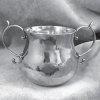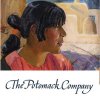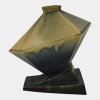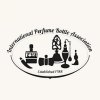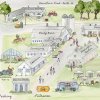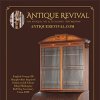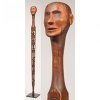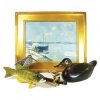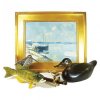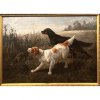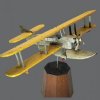Important American Furniture, Silver, Outsider Art, and Folk Art
September 20th, 2016
Christie’s, New York City
Photos courtesy Christie’s
Christie’s catalog for the September 20 Americana sale was small, just 8¼" x 6 5/8". The sale was small, just 144 lots. There was a small crowd at the sale with fewer than 15 bidders in the salesroom. Two dozen phones were available for bidders at two long phone banks, and online bidding was posted on an Internet screen identifying bidders from New York, Connecticut, Pennsylvania, Massachusetts, and Minnesota.
The sale will go down in auction history as the one that introduced the small catalog that fits in a woman’s handbag (most of the information was posted online) and for the big price—$427,500 with buyer’s premium—a new world record that was paid for a carved and painted American eagle made by itinerant Wilhelm Schimmel (1817-1890) of Cumberland County, Pennsylvania, who worked from 1865 to 1890. The eagle is 26" high with a 32" wide wingspan.
The new record shattered the existing one—$314,500 paid at Christie’s in 2010 for a Schimmel eagle, 17" high with a 33½" wingspan, from the Alastair Bradley Martin collection.

This monumental (26" high with a 32" wingspread) polychrome eagle, attributed to Wilhelm Schimmel, 1865-90, sold on the phone to a private collector for $427,500 (est. $100,000/150,000), underbid on the phone by another private collector. The last time it had been offered at auction, it was on the cover of the Sotheby Parke Bernet catalog for September 15, 1979, and estimated at $15,000/20,000 in the days when estimates were listed at the back of the catalogs. Then it had sold for $27,500 (when the buyer’s premium was 10%) to Jack Warner. Warner presided for 50 years over Gulf States Paper Corporation, a company with operations in wood and paper products, and he assembled a fine collection of American art. The eagle was consigned by the Jack Warner Foundation, which from 2002 until 2011 operated the Westervelt-Warner Museum of American Art in Tuscaloosa, Alabama. The price is a record for a Schimmel eagle, topping the Schimmel eagle with a 33½" wingspan from the estate of Alastair Bradley Martin, which sold at Christie’s in 2010 for $314,500.
“Schimmel is the Jean-Michel Basquiat of the folk art world,” said dealer David Schorsch of Woodbury, Connecticut, when asked if he bid on the bird. He did not bid. The Schimmel eagle was bought by an anonymous collector. According to auctioneer John Hays, the underbidder was also a private collector.
Two other six-figure prices were paid for rarities not likely to come to market again soon. A private collector paid $247,500 (est. $200,000/300,000) for a silver-hilted sword said to have been worn by Benjamin Franklin in his early days as diplomat at the court of Louis XVI in France. Canton, Massachusetts, dealer Gary Sullivan, bidding in the salesroom on behalf of a client, paid $187,500 (est. $40,000/80,000) for a pair of carved eagle-base card tables made in New York, 1820-40. These two items helped boost the total for the sale to $2,691,625, toward the middle of the presale estimates $1,703,000/2,914,000. Of the 144 lots offered, 120 sold, which is an 83% sell-through rate by lot.

Before he left France to return to Philadelphia in 1785, Benjamin Franklin gave his silver-hilted small sword to Pierre Jean Georges Cabanis (1757-1808), a young student of medicine and philosophy whom he had befriended. The sword passed down through ten generations of direct descendants to Emmanuel de Lipkowski, who has no heirs, so it was consigned to Christie’s for sale. It sold for $247,500 (est. $200,000/300,000) to a buyer who left a bid with the auctioneer. It is possibly a mid-18th-century Spanish sword. Its leather scabbard has a silver mount at the top (known as a locket) with the “SS” mark of Philadelphia silversmith Samuel Soumaine. A later 19th-century inscription on the sword reads, “Epée que portait Benjamin Franklin dans les combats livrés en Amérique pour la cause de la Liberté. / Il la donna depuis à son ami P.J.G. Cabania [sic]. (Sword worn by Benjamin Franklin in the battles fought in America in the cause of Liberty. / He then gave it to his friend P.J.G. Cabanis.)”
The mark of Soumaine (1718-circa 1769), who worked in Annapolis and Philadelphia, suggests Franklin acquired it in Philadelphia and took it with him to France. The sword was not unknown. It had been exhibited at the 1893 Chicago world’s fair and again in France in 1976 for the bicentennial. According to a note in the catalog, Soumaine was a neighbor of Franklin in Philadelphia. Trained by a relative in New York, before going to Annapolis and then moving to Philadelphia, Soumaine advertised in Philadelphia from 1754 to 1765. Surviving correspondence indicated that Franklin and Soumaine were neighbors and in frequent contact. It is believed that the Spanish sword was in Soumaine’s shop either for assembly or repairs, long enough for Soumaine to put his mark on the silver band. Scientific tests proved that the sword and scabbard are made of metal of the same composition consistent with 18th-century silver.
It is believed that Franklin would have worn a dress sword for court appearances. He was still a loyal English subject and followed courtly customs on his early trips abroad in 1757-62 and 1764-75. After the Revolution when he visited Europe he wore his American brown suit, signature glasses, and no wig. Franklin met Cabanis through Madame Helvétius, a widow whose house was a center for French intellectuals. Cabanis lived in an outbuilding on her estate and served as her secretary, and she bequeathed her estate in Auteuil to him. Franklin and Canabis were members of the same Masonic lodge; the two men saw each other frequently to talk about science and politics and kept in touch when Franklin returned to America. Franklin made Cabanis and some other Frenchmen honorary members of the American Philosophical Society. In his memoirs Cabanis wrote that Franklin left several mementos to him as “relics and as memories of friendship.”

A pair of eagle-base Classical card tables, New York, 1820-40, from the Jack Warner Foundation, sold for $187,500 (est. $40,000/80,000) to dealer Gary Sullivan in the salesroom. At Sotheby Parke Bernet in January 1980 they had sold for $28,600 (when the buyer’s premium was 10%).
What does this early season sale tell us about the market for Americana? It offered a selection of folk art, Outsider art, 18th- and 19th-century furniture ranging from early New England chests made in Massachusetts and Connecticut to Renaissance Revival and Aesthetic Movement furniture made in New York by Herter Brothers and Pottier and Stymus, as well as a selection of classic Queen Anne, Chippendale, and Federal furniture to give a reading on a broad spectrum.
Pennsylvania folk art sold well but perhaps not as well as it might have in Pennsylvania, where fraktur would be offered singly and not in groups of three. A few Pennsylvania collectors came to the sale. Others competed online or on the phone for the fraktur and folk art from the estate of the late Daniel Dietrich, who, Hays said, inherited most of his folk art from his brother Bill. Dealers confirmed that they had sold some of it to Bill, who predeceased his brother Daniel. Of the three Dietrich brothers, Richard was the most serious collector of Americana; he established the Dietrich American Foundation, which has benefited the collection at the Philadelphia Museum of Art (PMA). Daniel collected paintings and photography and also left some special works of art to the PMA.

Two phone bidders and bidders in the salesroom wanted this 3½" x 4½" red, black, and yellow bird fraktur drawing by Jacob Henly, possibly northern Lancaster County or Huntington County, Pennsylvania, and inscribed “Jacob Henly his Quill 1819.” It sold on the phone for $21,250 (est. $1000/2000). At Christie’s sale of the collection of Mr. and Mrs. Richard Flanders Smith at the Lebanon Valley Exposition Center on June 3, 1995, it had sold for $10,925 to Bailey Island, Maine, dealer James Glazer, underbid by dealers David Wheatcroft and David Schorsch. It was part of a consignment from the estate of Daniel W. Dietrich, who, according to John Hays, had inherited it from his late brother William, who was influenced to collect Americana by his brother H. Richard Dietrich Jr. The Dietrich American Foundation has supported the collections of American furniture and decorative arts at the Philadelphia Museum of Art.
The first lot in the sale, a fraktur drawing of a bird in many colors, signed by Jacob Henly, estimated at $1000/2000, sold for $21,250. That set the tone of the sale. Three lots later, a tiny horse and rider drawing, just 4" x 3", attributed to the Washington-Sussel Artist (worked 1760-85), probably Lancaster County, one of only four horse and rider drawings by the artist, sold on the phone for $43,750 (est. $8000/12,000) to dealer David Wheatcroft of Westborough, Massachusetts, underbid in the salesroom by Patrick Bell of Olde Hope Antiques, New Hope, Pennsylvania. John Hays thought it might have brought more. A condition report suggested that it had been restored with patches, which may have deterred bidders. Wheatcroft said patches were not there. “I examined it out of the frame, and it was backed by thin Japanese paper; it was in fine condition,” he said.
Some other fraktur were good buys. Wheatcroft bought three fraktur drawings of birds for $4750. Just one of them, a bird with flowers, had sold at Christie’s at the on-site Flack sale in 1997 for $6325, and another had sold in 1998 at Sotheby’s for $3450. Wheatcroft said he had owned the third fraktur before. Paul Flack, now 90, and his wife, Rita, came to the sale and bought two lots of fraktur.

This horse and rider fraktur drawing, attributed to the Washington-Sussel Artist, 1760-85, Lancaster County, is inscribed “Jakob ist mein Nahme.” The 4" x 3" drawing has some professional restoration. From the estate of Daniel Dietrich, it sold on the phone for $43,750 (est. $8000/12,000) to Massachusetts dealer David Wheatcroft, underbid in the salesroom by Patrick Bell of Olde Hope Antiques, New Hope, Pennsylvania. “I know of only four horse and riders by this hand, and it’s the smallest; I never saw one this size,” said Wheatcroft on the phone after the sale. “It is in remarkably good condition; it had been reinforced with rice paper, and there are not patches,” he said. “I examined it out of the frame.”

A group of three watercolor and ink fraktur bookplates from the late 18th/early 19th century—one with a heart flanked by two mermaids; a songbook for Samuel Rener dated 1789, attributed to Johan Adam Eyer; and the third a bookplate for Diedrich Braun—sold in the salesroom for $17,500 (est. $2000/4000) to collector Paul Flack. They measured from 3¾" x 6½" to 7½" x 6 5/8". Flack bought another group of three fraktur for $1375 (est. $1500/3000).

Bidders on phones and on the Internet competed for this painted and polychrome-decorated hanging box, possibly Berks County, Pennsylvania, and inscribed on the lid “Chrisdina Hoffman, jahr 1841” and initialed “CH” twice, 8 3/8" x 12 7/8" x 5½". It sold for $56,250 (est. $10,000/15,000). At Christie’s sale of the collection of Mr. and Mrs. George W. Scott Jr., June 1994 in Lancaster, Pennsylvania, it had sold for $57,500 (est. $6000/9000) to Leigh Keno (when the buyer’s premium was 15%, not the 25% charged today). The hammer price at the Scott sale was $50,000, and at Christie’s 22 years later it was $45,000. This time it was considered a fair price for a good example. According to both catalogs, the decoration relates to designs on fraktur by Samuel Bentz, once known as the Mount Pleasant Artist, who worked in Lancaster County. More vibrant boxes by this hand have sold for more. At the sale of the Ralph Esmerian collection at Sotheby’s, for example, a larger and more vibrant box by the same hand (misattributed in Sotheby’s 2014 catalog) sold for $377,000 to a Pennsylvania collector.
A painted pine hanging box, which had sold for $57,500 (est. $6000/9000) back in 1995 at Christie’s sale of the Mr. and Mrs. George Scott collection, sold this time for $56,250 (est. $10,000/15,000). The hammer price at the Scott sale was $50,000, and at Christie’s 22 years later, $45,000.
A selection of 20 lots of Outsider art followed the section of folk art. Only four of those 20 lots failed to find buyers. The featured limestone Critter by William Edmondson, a geometric 12" x 31½" form, sold on the phone to a collector for $81,250 (est. $50,000/150,000). One private collector on the phone (bidding number 1759) bought half a dozen lots, including one by James Castle for $9375 (est. $5000/10,000); a Bill Traylor green drawing of two men and a dog for $40,000 (est. $30,000/50,000); a Bill Traylor construction for $60,000 (est. $20,000/40,000); one by Thornton Dial for $20,000 (est. $20,000/40,000); and a landscape by Martin Ramirez for $32,500 (est. $30,000/50,000). This adds up to a representative collection of the “old masters” of Outsider art.

Bill Traylor (1854-1949) drew Construction with Six Figures and a Dog, 1939-42. It is 11½" x 7 7/8". The graphite on card with a Charles Shannon label sold for $68,750 (est. $30,000/50,000). Cara Zimmerman, who put together the folk art part of the sale, said she was pleased that the four Traylors in the show, each from a different part of his work, all sold above high estimates for prices ranging from $40,000 to $68,750.
Christie’s specialist for this genre, Cara Zimmerman, said that Outsider art is now a permanent part of Americana sales. “For January I am working on consignments of contemporary Outsider art and black folk art by the artists included in the 1983 black folk art in America exhibition,” she said. “The sale will cover the history of the field and point to its future.”
The fact that prices of American furniture have settled at a lower level was reflected in estimates and results. A Connecticut “Sunflower” chest with a new top sold on the phone for $30,000 (est. $20,000/30,000). The Wunsch Americana Foundation paid $32,500 (est. $25,000/35,000) for a Hadley chest, cataloged as having a new top, but some believed the top had been off and put back on and might be the original. It has the initials “S B,” possibly for a member of the Belding family. A Newport, Rhode Island, Queen Anne mahogany tray-top tea table, the sort that sold for between $50,000 and $100,000 a decade ago, sold for $25,000 (est. $20,000/30,000). Another similar table with a patched toe sold for $27,500 (est. $30,000/50,000). According to the catalog for Art and Industry in Early America: Rhode Island Furniture, 1650 to 1830 (an exhibition at the Yale University Art Gallery), there are 60 of these tables known and only one signed by its maker, Christopher Townsend. It is on view at the exhibition.

A 30¼" x 25 3/8" x 15 3/8" Classical carved and figured mahogany worktable, attributed to the shop of Duncan Phyfe (1768-1854), New York, 1810-20, sold on the phone for $18,750 (est. $30,000/50,000). When it sold at the sale of the collection of Mr. and Mrs. Bertram Coleman at Christie’s in January 1998, it went to Israel Sack, Inc. for $107,000 (est. $20,000/30,000). In the Coleman catalog, it merited a full page in color, and the legs and feet were compared to a card table at the Garvan collection at Yale, also pictured in the Coleman catalog.
A Boston Chippendale side chair with hairy-paw feet (its splat was based on plate 12 of Chippendale’s 1754 Director) had been offered at Christie’s last January with a $30,000/50,000 estimate and failed to sell. This time it sold on the phone to dealer Frank Levy of Bernard & S. Dean Levy, New York City, for $22,500 (est. $12,000/18,000). “It has some repairs, but it is one of only five or six Boston hairy-paw-foot chairs,” said Levy. A Federal inlaid mahogany demilune commode, attributed to John and Thomas Seymour of Boston, circa 1810, sold on the phone to the same buyer for $15,000 (est. $15,000/30,000). A Federal sideboard with reeded legs failed to sell (as it also had failed in January) but was sold to the trade after the sale.

With an Associated Artists, Southport, Connecticut, provenance, this Aesthetic Movement mixed-metal and mother-of-pearl inlaid and carved rosewood settee, cataloged as attributed to Herts Brothers (active 1872-1937) of New York, last quarter of the 19th century, 35½" x 63¾" x 25", sold on the phone for $16,250 (est. $5000/10,000).

This set of eight Aesthetic Movement carved oak dining chairs, attributed to Herter Brothers (1864-1906), New York, circa 1880, includes six side chairs and two armchairs. The side chairs are 35½" high; the armchairs are 38½" high. The set sold on the phone for $81,250 (est. $20,000/30,000), underbid by Margot Johnson.

This Renaissance Revival parcel-gilt inlaid and carved rosewood marble-top table, attributed to Herter Brothers (1864-1906), New York, circa 1869, has D-shaped ends fitted with drawers. The 28½" x 46¼" x 31¼" table sold for $21,250 (est. $5000/10,000) to dealer Margot Johnson, underbid by four phone bidders and a bidder online.
The surprise of the sale was the strength in the market for Renaissance Revival and Aesthetic Movement furniture. Margot Johnson, who retired and closed her shop six years ago and moved to France, has returned to Manhattan and opened a shop—by appointment at 17 East 70th Street. She came to the sale with a shopping list. She said her clients are collectors and museums. Of the 12 lots of Gilded Age furniture in the sale, Johnson bought five and underbid another. “It is rare to find a pair of Aesthetic Movement lamps,” she said after buying a pair of English gilt metal lamps with round glass globes for $2500 (est. $2000/4000). She said she owns three of the chairs from the drawing room of Elm Park, the Lockwood-Mathews Mansion in Norwalk, Connecticut, that go with the Renaissance Revival parcel-gilt inlaid carved rosewood table with an onyx top attributed to Herter Brothers. She bought the table with the same history as the chairs for $21,250 (est. $5000/10,000). A pair of Renaissance Revival parcel-gilt metal and porcelain-mounted upholstered armchairs by Herter, Pottier & Company went to Johnson for $18,750 (est. $15,000/30,000). She paid $32,500 for a Renaissance Revival carved mahogany and brass-mounted specimen marble-top center table, with a copper-lined drawer probably for cigars, and $81,250 (est. $20,000/30,000) for a set of eight Aesthetic Movement carved oak dining chairs, attributed to Herter Brothers, six side chairs and two armchairs. “I have never been able to buy a set of six side chairs and two armchairs by Herter, and these are related to Vanderbilt chairs, “ she said. “I had to have them.”
Johnson was the underbidder for an Egyptian Revival marble patinated and gilt bronze three-piece clock garniture. The clock has a sphinx on top, marked “T. & E. Dickinson, Buffalo, NY,” and is accompanied by two obelisks, each 23¾" high. The three-piece set sold to a phone bidder for $35,000 (est. $4000/6000). Other phone bidders bought multiple lots of late 19th-century furniture; only one of the dozen lots failed to sell. All of it came from a distinguished New York collection and cost a lot more when collected a generation ago.
This small stand-alone sale in New York City, held the Tuesday after the Chelsea bombing and when the UN was meeting and President Obama’s arrival in the city slowed traffic, showed that Christie’s has faith in the market for Americana and in absentee bidding. Some strong prices were paid for exceptional pieces, and overall the market seemed a bit healthier than it has been since the 2008 crash, even though many of the usual bidders never got to New York City to preview. More and more collectors depend on digital photographs and condition reports to influence their bidding or depend on the eyes of the trade.
David Wheatcroft, who was bidding for clients, said, “I think we need a larger supply for a robust market. It seems that as the number of collectors diminished, the supply of great material has dwindled.”
“It is a challenge to find the right material at the right estimates,” said Andrew Holter, head of American furniture at Christie’s. “I believe we have it right for January.”
For more information, call (212) 636-2230 or check the website (www.christies.com).

 This 61" x 44" oil on canvas, George Washington at Princeton, was painted in France about 1780 and attributed to Pierre Augustin Thomire (1724-1808) after Charles Willson Peale (1741-1827). It sold for $81,250 (est. $40,000/60,000). An original C. W. Peale George Washington at Princeton sold at the Mrs. J. Insley Blair sale in 2006 for $21,296,000. Charles Willson Peale’s large George Washington at Princeton showing the general at a key moment in the Revolutionary War measures 96½" x 61½". In 1779 Peale was commissioned by the Executive Council of Pennsylvania to paint a life-size full-length portrait of Washington. It hung in the State House, and several copies were made by Peale to be sent abroad to promote the ongoing fight for American independence. Mrs. Blair’s painting of Washington had been sent to Spain. The one Thomire copied (and he made four of them) is thought to be copied from the one sent to Louis XVI in 1779. Another copy signed by Thomire is at the Union Club in New York. Four paintings of Washington vary in size and are all smaller than Peale’s life-size full-length portraits. Another Thomire copy of C. W. Peale’s Washington had sold at Sotheby’s on December 3, 1992, for $33,000 (est. $15,000/25,000). The Thomire Washington sold here at Christie’s had been shown in the French Commissariat at the St. Louis World’s Fair in 1904. In the 1920s it was owned by Mortimer Loeb Schiff (1877-1931), who left it to his son John M. Schiff, after whose death in 1987 it was given to Yale University Art Gallery. The Yale gallery consigned it for sale to benefit its acquisition fund.
This 61" x 44" oil on canvas, George Washington at Princeton, was painted in France about 1780 and attributed to Pierre Augustin Thomire (1724-1808) after Charles Willson Peale (1741-1827). It sold for $81,250 (est. $40,000/60,000). An original C. W. Peale George Washington at Princeton sold at the Mrs. J. Insley Blair sale in 2006 for $21,296,000. Charles Willson Peale’s large George Washington at Princeton showing the general at a key moment in the Revolutionary War measures 96½" x 61½". In 1779 Peale was commissioned by the Executive Council of Pennsylvania to paint a life-size full-length portrait of Washington. It hung in the State House, and several copies were made by Peale to be sent abroad to promote the ongoing fight for American independence. Mrs. Blair’s painting of Washington had been sent to Spain. The one Thomire copied (and he made four of them) is thought to be copied from the one sent to Louis XVI in 1779. Another copy signed by Thomire is at the Union Club in New York. Four paintings of Washington vary in size and are all smaller than Peale’s life-size full-length portraits. Another Thomire copy of C. W. Peale’s Washington had sold at Sotheby’s on December 3, 1992, for $33,000 (est. $15,000/25,000). The Thomire Washington sold here at Christie’s had been shown in the French Commissariat at the St. Louis World’s Fair in 1904. In the 1920s it was owned by Mortimer Loeb Schiff (1877-1931), who left it to his son John M. Schiff, after whose death in 1987 it was given to Yale University Art Gallery. The Yale gallery consigned it for sale to benefit its acquisition fund.
Originally published in the November 2016 issue of Maine Antique Digest. © 2016 Maine Antique Digest
